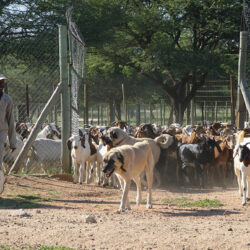Big News at the Model Farm!
-

- by Calum O'Flaherty October 7, 2019

The Cheetah Conservation Fund’s ‘Model Farm’ has been an integral part in mitigating human – wildlife conflict here in Namibia. We invite farmers from all over Namibia to come and understand our successful practices and encourage them to take ideas back to their own farms. Here, we promote livestock management as well as our Livestock Guarding Dog Program.
Recently, we have had a very special addition to our LGD program in the form of a new Anatolian Shepherd. The new eight month old female, Lisboa, was kindly donated by Baltazar Ramos and with the help from the the Jardim Zoologico de Lisboa in Portugal, and arrived here at CCF on Wednesday 2nd October. She has settled in very well and quickly and has become a staff and intern favourite with her sweet temperament and stunning looks. When she is older, she will become a pivotal part of our breeding program here at CCF. Her future puppies will help to make a real difference to farmers from across Namibia and who knows maybe further afield!
Lisboa’s arrival coincided with the opening of our new breeding pens, which have been named ‘The Penda Memorial Breeding Pens’ after a very special dog which recently passed away. Penda was an integral part of our breeding program during her time at CCF and then a much-loved pet when she was retired. She lived to the great age of 14 and during her breeding years helped over 50 farmers with dogs to protect their livestock. It seemed only apt that we name the new breeding pens after her. These new pens further cement CCF’s position in wanting to help the local communities, and in turn reduce human – wildlife conflict. With currently 20-30 puppies going out to farms each year, the six new pens allow us to double the amount of breeding individuals we can house, in turn increasing the number of placement puppies each year to around 70. This will be beneficial in helping our three-year waiting list of farmers who have heard about the program’s success.
The ‘Model Farm’ which has grown from strength to strength each year promotes the importance of livestock management in helping reduce livestock losses by 60%. We currently house 105 Boer Goats and 122 Damara Fat Tailed sheep which are the main form of livestock here in Namibia and are used for meat production. It is the high fencing and security of the kraal which is fundamental in keeping out any unwanted predators during the night as well as the loud barking of the dogs. Furthermore, the breeding of livestock at one time of the year (breeding season), allowing group raising of young in goat camps around the kraal until they’re big enough to go out with the herd, helps with this reduction in livestock losses. Finally, the importance of health checks on all of our livestock, both in the morning prior to release into the veld and in the afternoon once they’ve returned, also aids in decreasing livestock loss, as any injuries or illness can be treated promptly.
Both juvenile and ill/injured goat/sheep are very easy meals for any predator in the area! Here, at CCF we also house over 100 dairy goats (which originated from South Africa) to show farmers there is another form of income. and we use our goat’s milk it to make all sorts of cheeses, as well as various flavours of fudges and ice cream to name a few. We recently were donated a new yogurt creamery from our Turkish partners, the Turkish development agency, TIKA.

As part of the ‘Model Farm’ we promote the LGD program; the success of the dogs has resulted in a 80-100% reduction in livestock losses to the farmers who have the dogs. The breed, the Anatolian and Kangal Shepherd originated from two regions in Turkey and when Dr Marker started the programme in 1994 she identified these as ideal breeds for the program due to the similar terrain and temperature in Turkey (high desert) and because they were used to guard against bears and wolves over 5,000 years ago. With them working so well, we have monitored and researched the breed over the 25 years the program has been running. They have a lifespan of 12 – 15 years which is exceptional for a large breed and continue working into their teens. The dogs run perimeter checks when out with the herd, marking their territory; this smell of another predator (the dog) in the area is enough to deter most predators. If something does come closer the dog will stand between the herd and the predator and bark loudly and this takes away the easiness of the meal.
CCF’s breeding program is integral, helping the Namibian farmers in this manner. These dogs can have litters of average 8 puppies, and as with Lisboa, who came to us all the way from Portugal, we bring in dogs from countries outside of Namibia to maintain a strong genetic bloodline within our population of dogs, leading to the healthiest puppies possible. These puppies will grow up at CCF until they are 11 weeks of age, at which time they have been vaccinated, and neuters and are then placed on farms to begin the initial bonding process with the herd they will be guarding. They grow up within the herd and start going out with them at about 3 months of age, starting with half days and building up to full days. We conduct 3 month, 6 month and subsequent yearly visits to carry out check-ups and vaccinations on the dog. We currently have 165 dogs out on farms that we monitor regularly as well as the 17 at CCF. This is a mammoth task. However, with the help of an impressive team of Stella Emvula and Gebhardt Nikanor this becomes a much easier task and to date this program has placed 651 dogs!
I describe the LGD section as the best section of CCF. These dogs are the individuals who will truly be keeping Cheetahs in the wild safe. We are saving cheetahs one dog at a time!

Related Reading
-
July 4, 2024
Snake Aversion Training For Dogs Saving Cats -
February 5, 2023
Look at Nahanni Now -
November 6, 2021
Climate Change and Cheetahs



